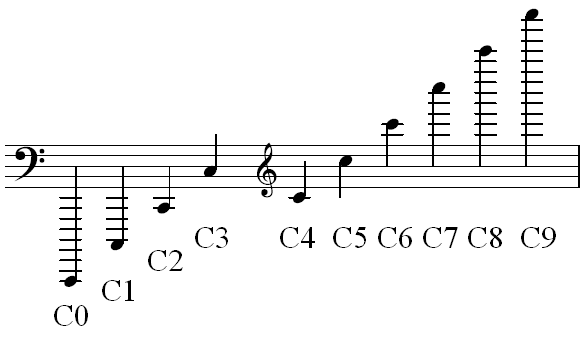
Scientific pitch notation
Scientific pitch notation (SPN), also known as American standard pitch notation (ASPN) and international pitch notation (IPN),[1] is a method of specifying musical pitch by combining a musical note name (with accidental if needed) and a number identifying the pitch's octave.
Although scientific pitch notation was originally designed as a companion to scientific pitch (see below), the two are not synonymous. Scientific pitch is a pitch standard—a system that defines the specific frequencies of particular pitches (see below). Scientific pitch notation concerns only how pitch names are notated, that is, how they are designated in printed and written text, and does not inherently specify actual frequencies. Thus, the use of scientific pitch notation to distinguish octaves does not depend on the pitch standard used.
Use[edit]
Scientific pitch notation is often used to specify the range of an instrument. It provides an unambiguous means of identifying a note in terms of textual notation rather than frequency, while at the same time avoiding the transposition conventions that are used in writing the music for instruments such as the clarinet and guitar. It is also easily translated into staff notation, as needed. In describing musical pitches, nominally enharmonic spellings can give rise to anomalies where, for example in Pythagorean intonation C♭
4 is a lower frequency than B3; but such paradoxes usually do not arise in a scientific context.
Scientific pitch notation avoids possible confusion between various derivatives of Helmholtz notation which use similar symbols to refer to different notes. For example, "C" in Helmholtz's original notation[2] refers to the C two octaves below middle C, whereas "C" in ABC Notation refers to middle C itself. With scientific pitch notation, middle C is always C4, and C4 is never any note but middle C. This notation system also avoids the "fussiness" of having to visually distinguish between four and five primes, as well as the typographic issues involved in producing acceptable subscripts or substitutes for them. C7 is much easier to quickly distinguish visually from C8, than is, for example, c′′′′ from c′′′′′, and the use of simple integers (e.g. C7 and C8) makes subscripts unnecessary altogether.
Although pitch notation is intended to describe sounds audibly perceptible as pitches, it can also be used to specify the frequency of non-pitch phenomena. Notes below E0 or higher than E♭
10 are outside most humans' hearing range, although notes slightly outside the hearing range on the low end may still be indirectly perceptible as pitches due to their overtones falling within the hearing range. For an example of truly inaudible frequencies, when the Chandra X-ray Observatory observed the waves of pressure fronts propagating away from a black hole, their one oscillation every 10 million years was described by NASA as corresponding to the B♭ fifty-seven octaves below middle C (B♭
−53 or 3.235 fHz).[3]
Scientific pitch versus scientific pitch notation[edit]
Scientific pitch (q.v.) is an absolute pitch standard, first proposed in 1713 by French physicist Joseph Sauveur. It was defined so that all Cs are integer powers of 2, with middle C (C4) at 256 hertz. As already noted, it is not dependent upon, nor a part of scientific pitch notation described here. To avoid the confusion in names, scientific pitch is sometimes also called "Verdi tuning" or "philosophical pitch".
The current international pitch standard, using A4 as exactly 440 Hz, had been informally adopted by the music industry as far back as 1926, and A440 became the official international pitch standard in 1955. SPN is routinely used to designate pitch in this system. A4 may be tuned to other frequencies under different tuning standards, and SPN octave designations still apply (ISO 16).[7]
With changes in concert pitch and the widespread adoption of A440 as a musical standard, new scientific frequency tables were published by the Acoustical Society of America in 1939, and adopted by the International Organization for Standardization in 1955. C0, which was exactly 16 Hz under the scientific pitch standard, is now 16.352 Hz under the current international standard system.[6]